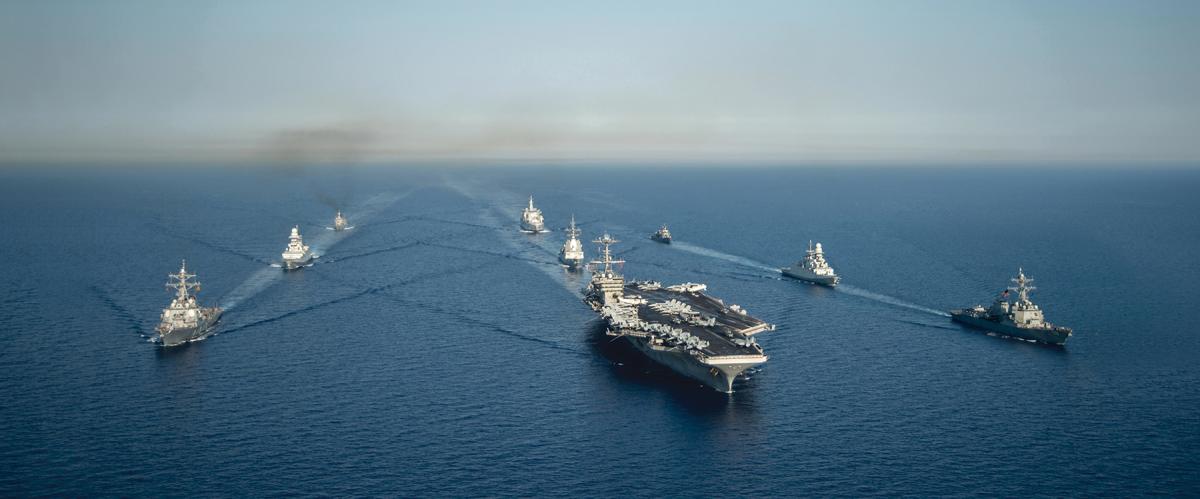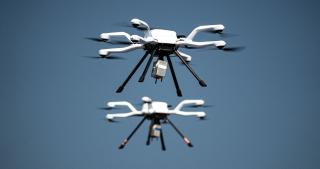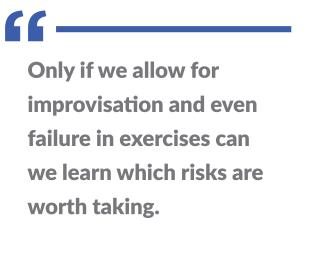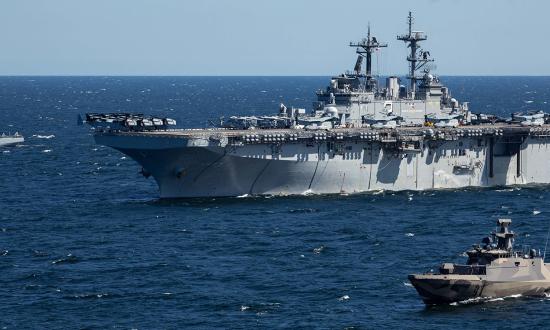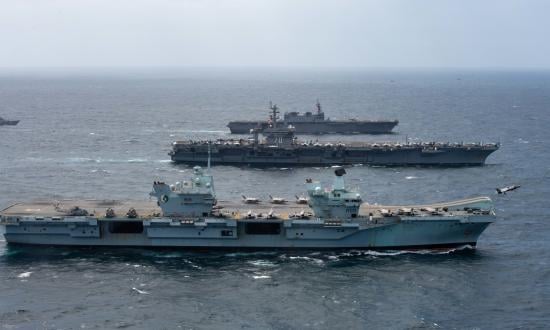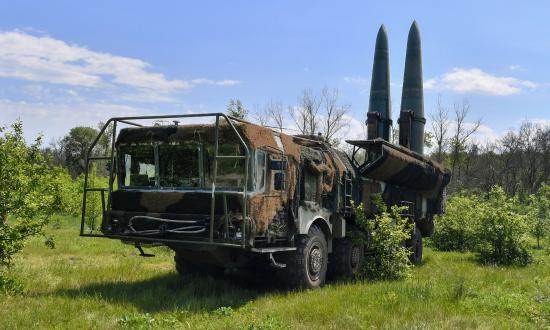Arguably, Russia’s attack on Ukraine on 24 February should have made life simpler for NATO strategists. All the uncertainties concerning Russia’s intentions and the likelihood of Russian aggression have now been painfully resolved, providing a firm basis for defining NATO’s deterrence posture—or so it seems.
In fact, new questions have replaced old uncertainties. Has the West underestimated Putin’s ruthlessness and his willingness to wage war while at the same time exaggerating Russian military prowess? What can we conclude from Russian operations and surprising ineptitude in the field or at sea? Would a conflict with NATO follow the same pattern? What future challenges do the reactions of countries in Africa and Asia portend?
The fundamental problems for naval planners remain the same: avoid planning and exercising for yesterday’s war; square “all domain” with “war at sea”; appreciate modern technologies without overestimating their efficacy in combat; and build a force for both the more probable tasks of crisis management and presence operations and the ultimate challenge of combat at sea. Russia’s war against Ukraine has not made the juggling act for naval planners any easier; it only shows the urgency of getting the balance right.
Analysis of Past Naval Operations
Even if we are determined not to fight the last war, we first need to take a fix to set a course. Here the problems begin: There are no recent naval operations—at least not in the NATO context of fighting or deterring high-intensity war at sea. All recent operations have been constabulary or, in some instances, strike operations.
The last “naval operations” still are those of the 1982 Falklands War. To this day, a primary source for learning about high-intensity warfare in the maritime domain on the unit level is David Hart Dyke’s account in Four Weeks in May of HMS Coventry’s fate in the Falklands.1 His experiences remind naval practitioners of the chaos and carnage war at sea will bring and the personal challenges naval leaders and their shipmates will face: stress, fatigue, intense pressure under a constant threat of surprise attacks. As the sinking of the Coventry—and, more recently, the Moskva—reminds us, war at sea is all about realizing destructive potential. Or as retired U.S. Navy Captain Wayne Hughes wrote, “to attack effectively first.”2
How, then, can we extrapolate how war at sea has evolved?
In the end, it boils down to gathering information, organizing it, and then bringing the right weapons to bear. So it was for Vice Admiral Lord Horatio Nelson off Cape Trafalgar in 1805, the Israeli Navy in 1973, and the Coventry in 1982, and so it will be in the future.
To be victorious, one does not have to be superior in every step of the interlocking processes that constitute naval combat. The British fleet at Trafalgar, for example, was inferior in numbers and net broadside weight to the combined French and Spanish fleet; however, the British used their fires more effectively and had better command and control (C2).3 The Israeli Gabriel missile was in every respect inferior to the Russian Styx, but both Israeli scouting and C2 were far superior, more than overcoming the deficiencies of the short-range Gabriel.4 A Royal Navy victory in the Falklands War was not a foregone conclusion.5 What tipped the scales was effective British counterfires, made possible by scouting and, again, highly effective C2, which enabled the massing of forces for mutual defense.
Blunt Strengths, Exploit Weaknesses
The secret to success always has been to blunt the effects of the enemy’s strengths and exploit his weaknesses. Today, Russian missiles outrange their Western opponents’ fires and sensors, and they seem to outwit and outrun them, too. This threatens to make conventional kinetic counterfires ineffective—or at least very inefficient.6 Observers beyond the circle of naval professionals accept this “missile gap” as a fact. Widely available charts showing circles around Kaliningrad or Tartus, portraying the whole Baltic Sea or eastern Mediterranean as “kill zones,” lead many to declare that Western naval activity other than submarine operations in these waters should not even be considered, thus crossing the “Ts” and dotting the “Is” of the West’s perception of a Russian antiaccess/area-denial strategy.7
However, if Nelson had drawn circles around the combined fleet, this article would be in French.
Instead of being discouraged by seemingly insurmountable odds, NATO needs to war game and then practice how to make its opponents’ indisputable advantages—fast, intelligent, long-range, and devastating fires in high numbers—ineffective. As the Israelis did in 1973. Or as Guy Hubin described in his book Perspectives Tactiques: saying farewell to larger, easier to track military formations and welcoming the development of more loosely aligned, smaller, and nonlinear formations by delegating authorities down to the lowest levels and linking these entities with modern technology.
Hubin derived his recommendations from the assumptions that modern warfare is based on the ability to know precisely and in real time where all of one’s own forces are, the ability to fire while constantly maneuvering, and precise indirect fires.8 While Hubin’s findings predominantly were in the land domain, they are relevant in the maritime domain, as well.
NATO navies should start by challenging the tenet of massing for mutual defense, which principally is how we have protected high-value assets for decades, whether aircraft carriers or reinforcements coming across the Atlantic. The first priority should be to not present a target at all. Instead of organizing a naval force for organic scouting and defense, we should prioritize aligning fires ranges with sensor information from other domains or subdomains, especially subsurface. We should exploit the fact that current weapon ranges exceed sensor ranges: Bring antiscouting tactics to the cyber age. But to do that, we will have to leave the confines of the maritime domain.
Multidomain Operations
Even though “multidomain operations” is becoming a buzz phrase, today’s war at sea cannot be fought successfully at sea alone. NATO’s navies must tap further into the cyber, air, and space domains. Instead of trying to reciprocate the adversary’s superior fires, we should focus on breaking his decision cycle.
The role of drones should be examined beyond their current predominant use as either intelligence, surveillance, and reconnaissance (ISR) or weapon platforms. Drones can play a decisive role in spoofing and misleading an opponent’s scouting efforts. In the land domain, the war in Ukraine has shown the versatile potential of even relatively cheap and unsophisticated drones. Connecting and operating them in swarms could saturate an enemy’s radar systems and stimulate defense systems, emptying limited ship-based missile silos and revealing enemy dispositions.
Western navies also must ask how they can avoid being targeted in a big-data world, and, conversely, how they can fool artificial intelligence (AI) systems analyzing their unavoidable data trails to present false targets. Not all these questions are for cyber nerds; they are questions for naval tacticians, too.
Since the Falklands War, European navies generally have trained in the skills of classic warfare at sea. Exercise scenarios cover engagements between submarines, ships, and naval aircraft with mostly the same goal: protecting convoys or achieving sea denial or sea control. But if Wayne Hughes is right in his fourth cornerstone—the seat of purpose is on land—then there should be a stronger focus on naval warfare influencing joint operations.9 Those who speak of joint and dream of multidomain must acknowledge the need for maritime fires to support land and air operations. Particularly in the early stages of an engagement with a peer competitor, neutralizing enemy air defenses will be critical to enable NATO’s core strength: air power in quality and quantity. The sensors and weapons of modern air-defense ships, range-enhanced munitions guided by satellite-based navigation systems, and maritime strike missiles will have a crucial role in supporting allied land operations simply because “from the sea” often will be the only avenue of access.
Since the times of Greek triremes, naval warfare has been driven by technology. But investing to match Russian strength in antiship cruise missiles might not be a wise decision. Striving for dominance in cyberspace is. In addition to unmanned systems, European navies should prioritize satellite and laser communication with high bandwidth and resilience and electronic warfare capabilities for funding.10 However, the quip “There can never be enough bandwidth,” so often heard in combat information centers (CICs) around the fleets, is a bad testament to the way we command, control, and communicate in operations down to the lowest tactical levels.
Increasingly, the abundance of available information can neither be transmitted nor made properly useful in our ships’ CICs. In addition, dependence on the exchange of information has made us vulnerable to attacks on the information itself or the means of communication. This dependence can be lethal, if the C4I backbone we have learned to rely on is broken early in a conflict.
Antisatellite weapons, signal- and communication-intelligence satellites, and drone-based electronic warfare are the nightmares of network-centric warfare. “Days without space,” no satellite communication, no GPS, need to be practiced more often—and at higher echelons. If you cannot be sure you will be able to reach your task groups reliably once they are past the breakwaters, you will spend a lot more time drafting your commander’s intent in the operations order. Cyber age or not, we have to relearn this art, this “Nelson touch.”11
Conventional warfare exercises are not past their time. In fact, anecdotal evidence from the Age of Sail to modern times shows two things: First, training and exercising are essential to prevail under the stress and chaos of battle. Superior training will not defeat an incoming missile by itself, but it goes a long way and at least helps deal with the consequences.12 Thorough, demanding, repetitive training will always be the baseline of any effective fighting force. Second, technology hardly ever keeps its promises. Sensor and weapon technical performance data often deviates from the reality at sea, as any experienced naval officer can corroborate.
At the same time, weapon systems can hold welcome surprises for naval operators. Unintended and unforeseen uses of weapon systems are common; Western navies have to be innovative and—to use a slightly stretched term—agile to exploit these opportunities.
Of course, it is easy to demand agility and innovation; implementation within military organizations is more difficult. Small yet significant successes in further developing tactics and procedures are possible through communities of practice. Experienced sailors are eager to share their ideas. These communities of practice of naval and maritime professionals exist informally and in every navy, be it on social media, in messenger groups, or in classic associations. Harnessing the ideas and suggestions of these experts through casual conferences or low-threshold meetings can avoid cumbersome bureaucracy and idea-stalling hierarchy and inform better and more meaningful naval exercises.
Trent Hone’s book Learning War, which examines how the U.S. Navy learned and relearned to fight in the Pacific, holds a lot of insights for the future.13 Training and exercising must be repetitive, but that is not enough. It also has to be competitive.14 Naval combat has no awards for second place. Merely following the script will not suffice—not in war and therefore not in exercises. Only if we allow for improvisation and even failure in exercises can we learn which risks are worth taking. Small ship numbers and limited funds may point toward top-down rationalization, centralization, and uniformity, but these have hardly ever resulted in innovation and risk-taking.
Flexible Force Employment
Russia’s invasion of Ukraine has lent new urgency to the argument to refocus on high-end warfare. At least since 2014, increasing demands for combat forces have competed with the cycle of maintenance, workups, and deployment for the same forces. For the German Navy as for many others, the constant employment in constabulary force operations has significantly hurt readiness.
However, hopes that in the light of the Russian aggression on our doorstep, we may eventually be relieved of our obligations to send capable warships to low-intensity operations around the globe are unrealistic. There is no clear-cut separation between the “higher end” of force-on-force kinetic naval operations and the “lower end” of constabulary force/crisis response operations, not in an operational understanding and even less so on a strategic level.
Crisis response operations off the coast of Africa or in the Middle East will continue to compete with NATO’s requirements for Europe’s naval forces, simply because there is no shortage of new challenges and no satisfying answer on how to finish these engagements. In the pursuit of their strategic goals, Russia and China increasingly instrumentalize and even stoke the conflicts and crises our armed forces deploy to manage—whether in the form of so-called gray zone operations or simply by the influence they exert on the parties to these conflicts. The boundaries of low and high are increasingly blurry. Thus, on a strategic level, instead of pitting “crisis response” against “deterrence and defense,” we must understand them as a whole and treat them as such.
This requires acknowledging that exercises and constabulary force operations have strategic meaning beyond their immediate objectives. Planning and conducting these events therefore has to allow for a more flexible employment of forces, starting with the legal constructs and continuing with how forces are generated for crisis response operations. Settings that bind forces for months into maritime interdiction operations will have to make way for arrangements that allow naval forces to switch between participating in crisis response, exercises, and NATO’s standing forces more easily.
In the end, Russia’s war against Ukraine shows how deadly the consequences are if NATO navies do not get the balance right.
The opinions expressed here are the personal views of the authors.
1. David Hart-Dyke, Four Weeks in May: A Captain’s Story of War at Sea (Bloomsbury, UK: Atlantic Books, 2008).
2. CAPT Wayne P. Hughes Jr., USN (Ret.), Fleet Tactics: Theory and Practice (Annapolis, MD: Naval Institute Press, 1986), 34.
3. Michael A. Palmer, “Lord Nelson: Master of Command,” Naval War College Review 41, no. 1 (Winter 1988).
4. Efraim Inbar, “The Israeli Navy,” Naval War College Review 43, no. 1 (Winter 1990). See also Raymond McConoly, “Battle of Latakia: An Operation Changed the Character of Naval Warfare,” NavalPost.com, 11 May 2021, navalpost.com/battle-of-latakia/.
5. ADM Sandy Woodward, RN, One Hundred Days: The Memoirs of the Falklands Battle Group Commander (Annapolis, MD: Naval Institute Press, 1992).
6. LCDR James Turnwall, USN, “The Navy Is Losing the Missile Arms Race,” U.S. Naval Institute Proceedings 145, no. 11 (November 2019).
7. Robert Dalsjö, Christofer Berglund, et al., Bursting the Bubble. Russian A2/AD in the Baltic Sea Region: Capabilities, Countermeasures, and Implications, FOI Report 4651–SE (Swedish Defense Research Agency, March 2019). See also Michael Kofman, “It’s Time to Talk about A2/AD: Rethinking the Russian Military Challenge,” War on the Rocks, 5 September 2019.
8. Guy Hubin, Perspectives Tactiques, 3rd ed. (London: Economica, 2009).
9. Hughes, Fleet Tactics, 33.
10. Michael Petersen, “Reconsider Russian Maritime Warfare,” CIMSEC, 11 April 2022.
11. Colin White, “The Nelson Touch: The Evolution of Nelson’s Tactics at Trafalgar,” Journal for Maritime Research 7, no. 1 (July 2005).
12. Milan Vego, General Naval Tactics: Theory and Practice (Annapolis, MD: Naval Institute Press, 2020), 318.
13. Trent Hone, Learning War: The Evolution of Fighting Doctrine in the U.S. Navy, 1898–1945 (Annapolis, MD: Naval Institute Press, 2018).
14. CAPT Robert C. Rubel, USN (Ret.), “Research & Debate—The Medium Is the Message: Weaving Wargaming More Tightly into the Fabric of the Navy,” Naval War College Review 72, no. 4 (Autumn 2019).



